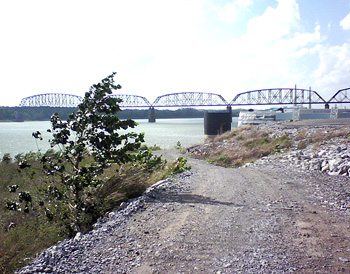Back in Time
Plank Roads
By Rickie Longfellow

Historic Plank Road of the 1920s. Used with permission from Jim Bremner of Desert USA.
Many of our Nation's roadways were once dirt and mud paths until the early to mid–1800s. A modern movement at that time called for the building of wooden roads, a great improvement in transportation. These planks-boards-were laid over the roadway on log foundations in various lengths, but most were eight feet long. Built for wagons, the width of the roads was 12 feet or more. In downtown areas the roads were wider.
Maintenance involved digging ditches on each side of the plank road to drain the water and keep mud from accumulating under and over the planks. By doing this, wagons loaded with merchandise and agricultural products-and the animals pulling them-were not slowed or stopped by mud, but could enjoy a hazard free ride once they reached a plank road. Bridges were also made from planks. Even now, we occasionally find a wooden bridge on our travels, similar to an old plank bridge.
Plank roads resembled a large set of train tracks in appearance, but felt and sounded much as boardwalks do today except most were wider than an average boardwalk. Early turnpike companies built these roads and there was often a toll charge of one to two cents per horse. The cost of building a plank road was from several hundred dollars to several thousand per mile, depending upon the climate and condition of the terrain.

Plank roads replaced dirt paths along rivers, greatly improving travel and trade.
Plank roads were still popular into the 20th century where the first motorists, struggling to negotiate muddy roads and bumpy gravel roads with their Model T, were all too happy to have a level surface on which to drive. Great fanfare often accompanied the opening of a plank road, just as today when a new stretch of highway is completed. In Lansing, Michigan, in July 1852, citizens gathered to celebrate the opening of the Lansing-Howell Plank Road. The stagecoach carrying the speaker for the ceremony could be heard approaching a mile away as it traveled over the new plank road. When the stagecoach came into view, the crowd began cheering. Finally, they had a roadway they could depend upon.
Like many inventions, the plank road was a progressive idea and enhanced local travel tremendously. However, after a few years of wear, the planks began to warp and rot away. The cost of repair, more lumber, gravel, toll buildings, employees, and management all came into play. As the planks deteriorated, gravel was used to compensate, making for a slower and bumpier ride.
A plank road was built in 1915 in Imperial County, California, as a way of crossing the from Southern California to Arizona. However, during high winds, sand blew onto parts of the roadway, preventing America's first automobiles from traveling any further until the sand could be removed. In addition, there was not enough room for two-way traffic. Still, despite the problems, many people reported that going out for a drive on the plank road was exciting and an important part of life at that time. The road is now Interstate 8.

Many gravel roads were later built over with planks.
Railroads continued their expansion, connecting more towns than the deteriorating plank roads so travelers began traveling more by rail. As for later plank roads, like California's Algodones Dunes plank road, progress in highway construction meant the eventual demise of the plank, but not before a two-way plank road could be constructed and used to cross the dunes.
Plank roads fell into history, many still lying forgotten underneath today's paved roads. During some construction, the City of Fayetteville, North Carolina, uncovered the log foundation of the Fayetteville Plank Road in the downtown area. One of the longest plank roads, it had been built in 1849 to connect this once remote area with current day Winston–Salem-129 miles away!
Gone but not forgotten, today's homeowners and businesses build small plank bridges over streams and flower beds with Cedar planks and pine arches. A six or eight-foot bridge can hold 500 pounds. Pedestrian plank footbridges lead the way into forests and over swampy areas in parks. Although not well known after all these decades, the original Plank Roads of the 19th and early 20th centuries had a prosperous impact on our economy and led to the need for the better, less costly roads we now enjoy.
Thank you to Jim Bremner of Desert USA. Read more about desert plank roads at: http://www.desertusa.com/sandhills/plankrd.html

